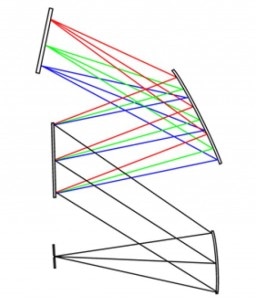The Exemplar® Plus from B&W Tek is a high performance smart spectrometer that utilizes a low stray light unfolded Czerny-Turner spectrograph. It has a highly sensitive TE Cooled back-thinned (BT) CCD detector, which is linearly summed for high dynamic range.
The Exemplar Plus’s long focal length combined with a high quantum efficiency detector provides excellent data quality across the entire 190-1100 nm spectral range. It has a high signal to noise ratio, which makes it perfect for low light level applications. It also has an integrated shutter that enables dark scan measurements, even while illuminated.
As a member of the Exemplar product line, it features USB 3.0 communication and on board data processing. The Exemplar product line is also optimized for multi-channel operation, which features gate jitter and ultra-low trigger.
As a standard configuration, the Exemplar Plus comes with: a LVF filter, wavelength range of 200 - 850 nm, a spectral resolution of 1.5 nm, 25 µm slit, and a ruled grating (800 mm/250 nm).
Applications
The key applications of the Exemplar Plus are as follows:
- Raman and fluorescence spectroscopy
- Low light level UV to NIR spectroscopy
- Gas and water analysis
- On-line process monitoring
- LED characterization
- LCD display measurement
Features
The key features of the Exemplar Plus are as follows:
Smart
On-board processing including averaging, smoothing, and dark compensation.
Speed
Obtains and transfers over 140 spectra/second at an integration time of 6.3 ms.
Synchronous
Supports up to 32 devices with gate jitter (+/- 20 ns) and ultra-low trigger delay (95 ns).
Signal to noise ratio:
| On-board Averaging 1 |
~540 |
| On-board Averaging 10 |
~1900 |
| On-board Averaging 100 |
~4800 |
Additional Features
- High UV, Vis, and NIR response
- Detector elements: 2048
- Over 60% QE at 200 nm
- Integrated shutter
- Configurable cooling temperature (0° default)
- Over 90% peak QE
Specifications
The key specifications of the Exemplar Plus are as follows:
| Power Input |
5 V DC @ 6 A (Maximum at Startup)
5 V DC @ 2.5 A (Typical at Normal Operation) |
| Detector Type |
Back-thinned CCD Array |
| Wavelength Range |
190 nm - 1100 nm |
| Detector Pixel Format |
2048 Effective Detector Elements |
| Effective Pixel Size |
14 µm x ~0.9 mm |
| Spectrograph f/# |
3.6 |
| Spectrograph Optical Layout |
Standard Czerny-Turner |
| Dynamic Range |
50,000 (Typical) |
| Digitizer Resolution |
16-bit or 65,535:1 |
| Data Transfer Speed |
>140 Spectra per Second at Integration Time of 6.3ms in Burst Mode |
| Trigger Delay |
95 ns +/- 20 ns (call for timing diagram) |
| Readout Speed |
> 400 kHz |
| Integration Time |
6.3 ms, Adjustable in 1 µs Increments |
| Aux Port |
External Trigger, 4 Digital Outputs (2 with Shutter Control), 2 Digital Inputs, Analog Input, Analog Output and System Reset |
| Operating Temperature |
5 °C - 35 °C |
| Operational Relative Humidity |
85% Noncondensing |
| CCD Cooling |
Default: 0 °C at Ambient of 25 °C. |
| Weight |
3.6 lbs (1.6 kg) |
| Dimensions |
7.40 in x 5.05 in x 2.80 in (188 mm x 128 mm x 71 mm) |
| Computer Interface |
USB 3.0 / 2.0 |
| Operating Systems |
Windows: 7, 8 (32-bit & 64-bit) |
Technical Details
Spectrograph

Entrance Slit
| Slit Option |
Dimensions |
Approx. Resolution 350-750 nm |
| 10 µm |
10 µm wide x 1 mm high |
Call |
| 25 µm |
25 µm wide x 1 mm high |
~1.8 nm |
| 50 µm |
50 µm wide x 1 mm high |
~2.9 nm |
| 100 µm |
100 µm wide x 1 mm high |
~4.5 nm |
| 200 µm |
200 µm wide x 1 mm high |
Call |
| Custom Slit Widths Available |
Diffraction Grating
| Best Efficiency |
Spectral Coverage (nm) |
Grating |
| Vis / NIR |
350 - 1050 |
400/550 |
| NIR |
750 - 1050 |
1000/900 |
| UV-NIR |
190 - 1100 |
300/280 |
| UV |
190 - 380 |
1500/250 |
| Custom Configurations Available |